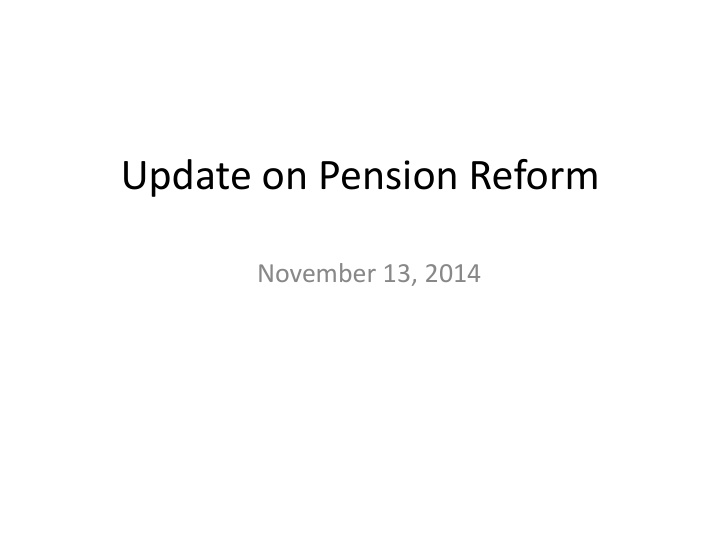



Update on Pension Reform November 13, 2014
Current Structure of Public Service Pension Plan (PSPP) • Provincial government is sole trustee of plan • Government guarantor • Defined Benefit Plan • EE/ER contributions + investments = defined benefit • 2% x years of service = pension • Reduced early retirement/unreduced early retirement/normal retirement
Problem with PSPP • Unfunded liability growing • $4.7 billion extra payments into plan by government since 1997-98 • In 2014, unfunded liability estimated at $4 billion • Pensions and other post-employment benefits (OPEBs) make up 74% of provincial debt • Pension reform taking place across country • Threat of legislation
Political Climate • Consultation started with Premier Dunderdale, Minister Marshall, Minister Kennedy • Winter of 2014, Premier Marshall took over • Business community lobbied for defined contribution plan (DCP) and removal of benefits • Premier Marshall publically stated support for defined benefit plan (DBP)
Political Climate cont. • Public commitment to retirees • Commitment to maintain accrued benefits • Uncertainty about new PC leader and outcome of 2015 provincial election. What stance might Liberals take?
Union Strategy • Five public sector unions work together • Avoid legislation • Influence government decisions • Work to get a deal before Premier Marshall leaves office • Maintain DBP and minimize impact on pension benefits
Consultation Process • Took place over 2 years • Included 6 weeks of intense negotiations • Real time modeling Eckler • Presentations on other plans/reform • Union hired expert pensions lawyer • Unions expertise on pensions
Government’s Position • Share unfunded liability 50/50 • Put $1.6 billion into plan • Move from best 5 years to career averaging and then best 10 • Early retirement age 60
Government’s Position (cont) • Three year transition period • Other post employment benefits would be paid be retiree (currently cost-shared 50/50) • Joint trusteeship
Union’s Position • Maintain defined benefit plan • Minimize impact on benefits • Has to be 100% before considering joint trusteeship
Union’s Position (cont) • Due to government’s promise to retirees, government owns their portion of the debt ($1.8 billion) – Government eventually agreed • Leaving $2.2 billion, unions agreed to cost share 50/50; about $1.1 billion.
Final Joint Position • Changes effective January 1, 2015 • 100% funded in 30 years • Government has to pay $2.685 billion, amortized over 30 years, $195 million/year • Union changes and contribution increase contribute about $1.128 billion
Contribution Increase Current PSPP Agreement for Reformed PSPP First $3,500 earnings – 8.6% First $3,500 earnings – 10.75% $3,501 to Yearly Maximum $3,501 to Yearly Maximum Pensionable Earnings (YMPE) – Pensionable Earnings – 8.95% 6.8% Above Yearly Maximum Above Yearly Maximum Pensionable Earnings – 11.85% Pensionable Earnings – 8.6% Implementation - January 2015
Pension Calculation Current PSPP Agreement for Reformed PSPP Best Average Earnings (BAE) - Best Average Earnings – best 6 best 5 years years (frozen BAE 5 for past service) Indexing on future service removed (no impact on current retirees) Implementation – January 2015
Unreduced Early Retirement Current PSPP Agreement for Reformed PSPP Age 55 with minimum 30 years Age 58 with minimum 30 years service service Or Or Age 60 with minimum 5 years Age 60 with minimum 10 years service service With five year transition under old rules Implementation – January 2015
Reduced Early Retirement Current PSPP Agreement for Reformed PSPP Age (minimum 55) plus Years of Age 53 with 30 years service Service equal 85 Age 59 with 29 years of service Or Age 55 with 5 years service Age 50 with 30 years service With 5 year transition under Or old rules Age 55 with 5 years service Implementation – January 2015
Other Post-employment Benefits (OPEBs) Current PSPP Agreement for Reformed PSPP Pension eligibility with minimum Pension eligibility with minimum 5 years service 10 years service With 5 year transition under old rules Implementation Date – January 2015
Grandparenting • Two ways to grandparent ( at the end of the 5 year transition period ) – Active or deferred pension members with 55/30 or 60/5 can receive early unreduced retirement anytime after the transition period – Active or deferred pension members with 30 years service can receive early unreduced retirement anytime after the transition period after they reach 55 years of age
Grandparenting (cont) • Window option – Any member who is eligible to retire with a reduced benefit will have the old rules apply during the transition period; after the transition period, the new rules apply
Joint Trusteeship • In conjunction with the Plan changes and government making a special payment of $2.685 billion, government and unions have agreed to a joint trusteeship arrangement
Joint Trusteeship (cont) • To equally share any actuarial surpluses and deficits • Creation of an independent corporation to oversee and manage the fund • Act as Sponsors responsible for future plan design changes and make decisions by their common agreement • Framework and funding policy to be determined
Next Steps • Negotiate joint trusteeship language • Important deadlines for achieving language: – October 31, 2014 – March 2, 2015
Information Sources • Government’s website: www.exec.gov.nl.ca/exec/hrs/pensions/plans_ps pp.html – Includes a self-serve pension estimator • Government by telephone: – PSPP information line at 709-729-3600 or toll-free at 1-844-373-9848 • Our website: www.nlnu.ca/mynlnu • NLNU Telephone Town Halls
Frequently Asked Questions • If I work an extra 3 years will I get an extra 6% when I retire? • What is the average retirement age of NLNU members? • As a new grad will there be a pension there for me when I retire? • When was the last contribution rate increase? • It seems like we are paying a lot. How do these rates compare with other pension plans?
Recommend
More recommend